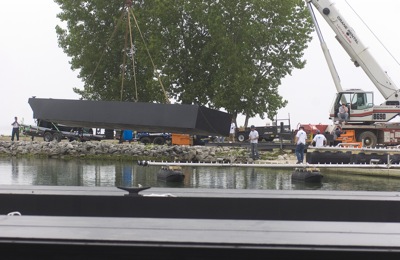Wednesday, May 25th, 2011
Preparing for alum
June 2 set for first treatment of lake
By Nancy Allen

Photo by Mark Pummell/The Daily Standard
Officials from HAB Aquatic Solutions of Lincoln, Neb., on Tuesday get equipment ready to apply 2.6 million gallons of alum to Grand Lake. Two boats will apply aluminum sulfate in the center portion of the lake between June 2 and 22, the state said.
GRAND LAKE - The first line of defense against Grand Lake's toxic blue-green algae is preparing to launch.
A Nebraska company Tuesday began mobilizing equipment at the West Bank boat ramp area to apply 2.6 million gallons of alum in the center of the lake.
Aluminum sulfate robs the algae of its main food source, phosphorous.
The application should start June 2 and end June 22, a news release from the state says.
Milt Miller, a member of the Lake Restoration Commission, this morning said he is excited that the application is about to begin.
"It's been a long time coming, and this spring has certainly presented its challenges, so we are greatly relieved that it is becoming a reality," Miller said. "We are optimistic the alum application will do all it has been touted to do by the scientists, and we will have a good lake this summer."
The state announced May 6 it was scaling back the application to treat only 4,900 acres in the center where phosphorous levels are highest instead of treating the entire 13,500-acre lake with a low dose. The application was pushed back from mid-May to early June due to heavy rains, which caused heavy runoff into the lake. State officials also were worried a more extensive application could cause a massive fish kill due to the water's low oxygen levels.
It is hoped this year's alum treatment will be enough to stave off severe algae blooms that curtail the lake's recreational usage and hurt the local economy. The state put strict water quality advisories on the lake the last two years due to massive algae blooms.
A public health advisory was put on the lake last week, advising against swimming, wading and swallowing the water due to algae toxins. Boating and eating the lake's fish are safe, the state said.
The $3.4 million alum treatment is being paid through the Ohio EPA Water Pollution Control Loan Fund and won't need to be repaid.
The community and lake visitors likely will see increased tanker-truck traffic bound for the West Bank boat ramp, the state says. The trucks will be delivering alum supplied by plants in Ohio.
Watercraft will not be restricted in the application area, but boaters are asked to give the vessels wide berth and right of way. Two boats will do the work.
The aluminum sulfate and sodium aluminate, a buffering agent that keeps pH levels from fluctuating so fish aren't stressed, are not hazardous to people or aquatic life. The buffering agent also helps reduce the possibility of damage to boat hulls, the state said.
The Ohio EPA and U.S. Geological Survey will monitor water-quality information before, during and after the project.
Money left from this year's planned $5 million treatment could be used to do a more optimal treatment next year, the state said. Officials expect having to do alum treatments for consecutive years to keep algae blooms at bay.
The alum application is one step in a multi-faceted, multi-year approach to restoring the lake. Increased dredging, rough fish removal, installation of a treatment train and other water quality initiatives continue.





